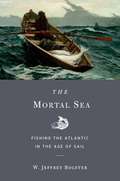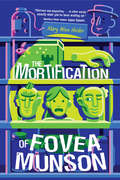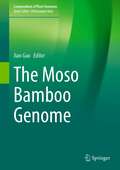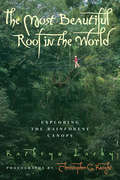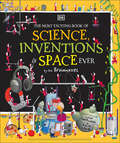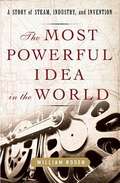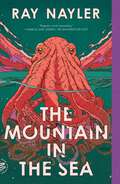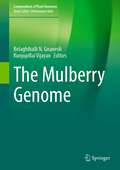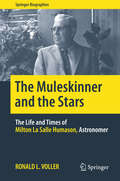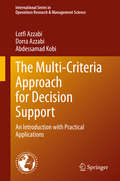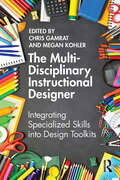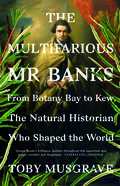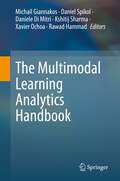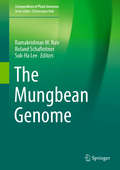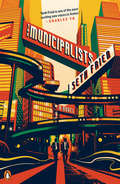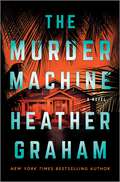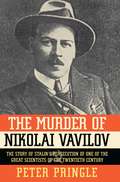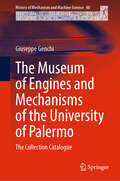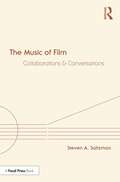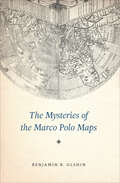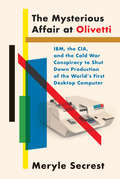- Table View
- List View
The Mortal Sea: Fishing the Atlantic in the Age of Sail
by W. Jeffrey BolsterSince the Viking ascendancy in the Middle Ages, the Atlantic has shaped the lives of people who depend upon it for survival. And just as surely, people have shaped the Atlantic. In his innovative account of this interdependency, W. Jeffrey Bolster, a historian and professional seafarer, takes us through a millennium-long environmental history of our impact on one of the largest ecosystems in the world. While overfishing is often thought of as a contemporary problem, Bolster reveals that humans were transforming the sea long before factory trawlers turned fishing from a handliner's art into an industrial enterprise. The western Atlantic's legendary fishing banks, stretching from Cape Cod to Newfoundland, have attracted fishermen for more than five hundred years. Bolster follows the effects of this siren's song from its medieval European origins to the advent of industrialized fishing in American waters at the beginning of the twentieth century. Blending marine biology, ecological insight, and a remarkable cast of characters, from notable explorers to scientists to an army of unknown fishermen, Bolster tells a story that is both ecological and human: the prelude to an environmental disaster. Over generations, harvesters created a quiet catastrophe as the sea could no longer renew itself. Bolster writes in the hope that the intimate relationship humans have long had with the ocean, and the species that live within it, can be restored for future generations.
The Mortification of Fovea Munson
by Mary Winn HeiderFovea Munson is nobody's Igor. True, her parents own a cadaver lab where they perform surgeries on dead bodies. And yes, that makes her gross by association, at least according to everyone in seventh grade. And sure, Fovea's stuck working at the lab now that her summer camp plans have fallen through. But she is by no means Dr. Frankenstein's snuffling assistant!That is, until three disembodied heads, left to thaw in the wet lab, start talking. To her. Out loud. What seems like a nightmare, or bizarre hallucination, is not. Fovea is somebody's Igor, all right. Three somebodies, actually. And they need a favor.With a madcap sense of humor and a lot of heart (not to mention other body parts), this is a story about finding oneself, finding one's friends, and embracing the moment.
The Moso Bamboo Genome (Compendium of Plant Genomes)
by Jian GaoThis book is the first comprehensive compilation describing the botanical traits, genetic resources, whole genome sequencing, Mitochondrial genome, transcriptomes of different organs with developmental stages, transcription factors, delineating gene evolution of gene family in Bambusoideae, alternative splicing (AS) and polyadenylation, case studies for economically important traits such as internode length, shoot fast growing, flowering, ageing and stress-resistant genes and small RNAs-mediated gene regulation of moso bamboo flowering and other developmental stages. Applications of transcriptome and genome approaches in moso bamboo in general and the prospects of transgenic breeding and genome editing technologies in bamboo are also discussed. Altogether, the book comprises eleven chapters covered over 200 pages authored by the researchers involved in genomic science, molecular biology, and breeding. This book appeals to graduate students, post-graduate students, research scholars, researchers, and industry players in the field of plantation bamboo in general, bamboo processing and bamboo garden owner and fans of bamboo culture in particular.
The Most Beautiful Roof in the World: Exploring the Rainforest Canopy
by Kathryn Lasky Christopher G. KnightFrom Newbery Honor author Kathryn Lasky comes a fascinating journey through the rainforest canopy that's perfect for budding environmentalists. Journey along with Dr. Meg Lowman, a scientist who, with the help of slings, suspended walkways, and mountain-climbing equipment, has managed to ascend into one of our planet’s least accessible and most fascinating ecosystems.
The Most Exciting Book of Science, Inventions, and Space Ever (Serendipity)
by DKTravel with mischievous cartoon guides, the Brainwaves, in this book of science through a range of mindblowing STEM topicsMeet the Brainwaves, hilarious little mischief-makers who will be your guides to a marvellous range of mindblowing science topics! These pint-sized pals will jump aboard the invention of the car, take you on a madcap holiday to Mars and outer space, and will even shrink down to atomic level to explore the most basic building blocks of science. The Most Exciting Book of Science, Inventions, and Space Ever has a bunch of scientific discoveries that kids aged 8-12 will love to learn about - from the wisest and wackiest inventions the world has ever seen to the adventures of pioneering astronauts, plus all the core information they need to know, such as the periodic table, energy, forces, and matter. Each exciting illustrated adventure is packed with amazing facts and core information to learn about – from why gravity sucks to how the Industrial Revolution was powered.This STEM book for children features: - Step by step guides that give precise detail on scientific discoveries, planets, inventions and more!- Quirky characters deliver witty facts and asides, with a special new character to look out for in each part of the bind-up.- Mini biographies and profiles of key figures, events, and features.- Key subject areas, such as science and space, that are presented in an inventive and whimsical way.With a host of colorful characters offering entertaining insights on each subject, the Brainwaves will both delight children&’s eyes and broaden their knowledge. Even the most reluctant readers will be absorbed, by hysterical artworks teeming with tiny, wise-cracking Brainwaves that bring each topic to life and make facts fun. Through their zany antics, readers can take a fantastical foray into a range of fields, learning about science, space, and discovering more than 300 inventions.
The Most Powerful Idea in the World: A Story of Steam, Industry, and Invention
by William RosenIf all measures of human advancement in the last hundred centuries were plotted on a graph, they would show an almost perfectly flat line--until the eighteenth century, when the Industrial Revolution would cause the line to shoot straight up, beginning an almost uninterrupted march of progress. In The Most Powerful Idea in the World, William Rosen tells the story of the men responsible for the Industrial Revolution and the machine that drove it--the steam engine. In the process he tackles the question that has obsessed historians ever since: What made eighteenth-century Britain such fertile soil for inventors? Rosen's answer focuses on a simple notion that had become enshrined in British law the century before: that people had the right to own and profit from their ideas. The result was a period of frantic innovation revolving particularly around the promise of steam power. Rosen traces the steam engine's history from its early days as a clumsy but sturdy machine, to its coming-of-age driving the wheels of mills and factories, to its maturity as a transporter for people and freight by rail and by sea. Along the way we enter the minds of such inventors as Thomas Newcomen and James Watt, scientists including Robert Boyle and Joseph Black, and philosophers John Locke and Adam Smith--all of whose insights, tenacity, and ideas transformed first a nation and then the world. William Rosen is a masterly storyteller with a keen eye for the "aha!" moments of invention and a gift for clear and entertaining explanations of science. The Most Powerful Idea in the World will appeal to readers fascinated with history, science, and the hows and whys of innovation itself.
The Mountain in the Sea: A Novel
by Ray Nayler*WINNER OF 2023 LOCUS AWARD FOR BEST FIRST NOVEL * FINALIST FOR THE NEBULA AWARD, and THE LOS ANGELES TIMES RAY BRADBURY PRIZE “The Mountain in the Sea is a wildly original, gorgeously written, unputdownable gem of a novel. Ray Nayler is one of the most exciting new voices I’ve read in years.”—Blake Crouch, author of Upgrade and Dark MatterHumankind discovers intelligent life in an octopus species with its own language and culture, and sets off a high-stakes global competition to dominate the future. The transnational tech corporation DIANIMA has sealed off the remote Con Dao Archipelago, where a species of octopus has been discovered that may have developed its own language and culture. The marine biologist Dr. Ha Nguyen, who has spent her life researching cephalopod intelligence, will do anything for the chance to study them. She travels to the islands to join DIANIMA’s team: a battle-scarred securityagent and the world’s first (and possibly last) android.The octopuses hold the key to unprecedented breakthroughs in extrahuman intelligence. As Dr. Nguyen struggles to communicate with the newly discovered species, forces larger than DIANIMA close in to seize the octopuses for themselves.But no one has yet asked the octopuses what they think. Or what they might do about it.A near-future thriller, a meditation on the nature of consciousness, and an eco-logical call to arms, Ray Nayler’s dazzling literary debut The Mountain in the Sea is a mind-blowing dive into the treasure and wreckage of humankind’s legacy.
The Mulberry Genome (Compendium of Plant Genomes)
by Belaghihalli N. Gnanesh Kunjupillai VijayanThis book is the first comprehensive compilation of current knowledge on mulberry (Morus L.) covering botany, cytogenetics, biodiversity, genetics and breeding, tissue culture and genetic transformation, biotic and abiotic stresses, molecular mapping, QTL identification, whole genome sequencing and elucidation on functional genomics. As mulberry is one of the most economically important trees in Asian countries, it has attracted the attention of both academicians as well as industrialists. Being highly heterozygous due to long juvenile life coupled cross pollination among species, the genetics of this important crop species is yet to be unravelled. Nonetheless, the recent success of sequencing the genomes of haploid and diploid domesticated species has ushered in an era of intense molecular and genetic research to understand this crop well for its better utilization for mankind.In this book, efforts have been made to bring together key information on origin and distribution, taxonomy, morphological features, economic importance, abiotic stress responses, disease and pest resilience, current breeding strategies and their constraints, progress and prospects of gene mapping, elucidation of genes controlling metabolic and physiological pathways, and their utilization in crop improvement which are elaborated in about 250 pages over 13 chapters authored by globally leading experts on the species presented.This book is useful to the sericulture community in the world in general and students, teachers, and scientists in the academia for forage and fruit production, genetics, breeding, pathology, entomology, physiology, molecular genetics, in vitro culture and genetic engineering, and structural and functional genomics. This book is also useful to seed and biofuel industries.
The Muleskinner and the Stars
by Ronald L. VollerThis is the story of the astronomer Milton La Salle Humason, whose career was integral to developing our understanding of stellar and universal evolution and who helped to build the analytical basis for the work of such notable astronomers and astrophysicists as Paul Merrill, Walter Adams, Alfred Joy, Frederick Seares, Fritz Zwicky, Walter Baade and Edwin Hubble. Humason's unlikely story began on the shores of the Mississippi River in Winona, Minnesota, in 1891 and led to the foot of Mount Wilson outside Los Angeles, California, twelve years later. It is there where he first attended summer camp in 1903 and was captivated by its surroundings. The mountain would become the backdrop for his life and career over the next six decades as he helped first build George Ellery Hale's observatory on the summit and then rose to become one of that institution's leading figures through the first half of the twentieth century. The story chronicles Humason's life on Mount Wilson, from his first trip to the mountain to his days as a muleskinner, leading teams of mules hauling supplies to the summit during the construction of the observatory, and follows him through his extraordinary career in spectroscopy, working beside Edwin Hubble as the two helped to reconstruct our concept of the universe. A patient, knowledgeable and persistent observer, Humason was later awarded an honorary doctorate for his work, despite having no formal education beyond the eighth grade. His skill at the telescope is legendary. During his career he photographed the spectra of stars, galaxies and other objects many thousands of times fainter than can be seen with the naked eye and pushed the boundary of the known universe deeper into space than any before him. His work, which included assisting in the formulation of Hubble's Law of redshifts, helped to set the field of cosmology solidly on its foundation. Milton Humason was one of the most charismatic characters in science during the first half of the 20th century. Uneducated, streetwise, moonshining, roguish, humble and thoroughly down to earth, he rose by sheer chance, innate ability and incredible will to become the leading deep space observer of his day. "The Renaissance man of Mount Wilson," as Harlow Shapley once referred to him, Humason's extraordinary life reminds us that passion and purpose may find us at any moment.
The Multi-Criteria Approach for Decision Support: An Introduction with Practical Applications (International Series in Operations Research & Management Science #300)
by Lotfi Azzabi Dorra Azzabi Abdessamad KobiThis book presents the multi-criteria approach to decision support, as well as the various multi-criteria tools to help avoid multi-objective optimization. The book is intended as a tool for understanding the multi-criteria tools for decision support and modeling in mathematical programming. It helps to structure models, to easily model complex constraints, to have a basic modeling guide for any multi-criteria system and to better understand models already existing in the literature.The book is structured in the same order as components of the methodology, established in a multi-criteria optimization problem. It introduces the elements of the actors, the decision-making activity under criteria, calculations, specifications and objective criterion.
The Multi-Disciplinary Instructional Designer: Integrating Specialized Skills into Design Toolkits
by Chris Gamrat Megan KohlerThe Multi-Disciplinary Instructional Designer explores how the instructional design and development process can be energized and deepened through principles gleaned from other fields of academic study. Despite their shared academic preparation and theoretical foundations, many instructional designers come to the profession also bearing formative knowledge from a diverse range of other subject areas, career tracks, creative practices, or intellectual pursuits. Their training, however, typically does not prepare them to leverage these specializations into the creation of more effective educational experiences and materials. This first-of-its-kind book guides instructional designers to apply key concepts, strategies, and lessons learned from a variety of disciplines – spanning the social sciences, arts and humanities, and STEM – to their practice. Chapters replete with example scenarios, reflection activities, and field-tested strategies provide an expansive yet actionable reframing of the profession’s potential. By seeking inspiration across disciplines and from the world at large, instructional designers will emerge with robust and revitalized toolkits, ready to enrich their approach to teaching and learning.
The Multi-Disciplinary Instructional Designer: Integrating Specialized Skills into Design Toolkits
by Chris Gamrat Megan KohlerThe Multi-Disciplinary Instructional Designer explores how the instructional design and development process can be energized and deepened through principles gleaned from other fields of academic study. Despite their shared academic preparation and theoretical foundations, many instructional designers come to the profession also bearing formative knowledge from a diverse range of other subject areas, career tracks, creative practices, or intellectual pursuits. Their training, however, typically does not prepare them to leverage these specializations into the creation of more effective educational experiences and materials. This first-of-its-kind book guides instructional designers to apply key concepts, strategies, and lessons learned from a variety of disciplines – spanning the social sciences, arts and humanities, and STEM – to their practice. Chapters replete with example scenarios, reflection activities, and field-tested strategies provide an expansive yet actionable reframing of the profession’s potential. By seeking inspiration across disciplines and from the world at large, instructional designers will emerge with robust and revitalized toolkits, ready to enrich their approach to teaching and learning.
The Multifarious Mr. Banks: From Botany Bay to Kew, The Natural Historian Who Shaped the World
by Toby MusgraveA fascinating life of Sir Joseph Banks which restores him to his proper place in history as a leading scientific figure of the English Enlightenment As official botanist on James Cook's first circumnavigation, the longest-serving president of the Royal Society, advisor to King George III, the "father of Australia," and the man who established Kew as the world's leading botanical garden, Sir Joseph Banks was integral to the English Enlightenment. Yet he has not received the recognition that his multifarious achievements deserve. In this engaging account, Toby Musgrave reveals the true extent of Banks’s contributions to science and Britain. From an early age Banks pursued his passion for natural history through study and extensive travel, most famously on the HMS Endeavour. He went on to become a pivotal figure in the advancement of British scientific, economic, and colonial interests. With his enquiring, enterprising mind and extensive network of correspondents, Banks’s reputation and influence were global. Drawing widely on Banks's writings, Musgrave sheds light on Banks’s profound impact on British science and empire in an age of rapid advancement.
The Multimodal Learning Analytics Handbook
by Michail Giannakos Daniel Spikol Daniele Di Mitri Kshitij Sharma Xavier Ochoa Rawad HammadThis handbook is the first book ever covering the area of Multimodal Learning Analytics (MMLA). The field of MMLA is an emerging domain of Learning Analytics and plays an important role in expanding the Learning Analytics goal of understanding and improving learning in all the different environments where it occurs. The challenge for research and practice in this field is how to develop theories about the analysis of human behaviors during diverse learning processes and to create useful tools that could augment the capabilities of learners and instructors in a way that is ethical and sustainable. Behind this area, the CrossMMLA research community exchanges ideas on how we can analyze evidence from multimodal and multisystem data and how we can extract meaning from this increasingly fluid and complex data coming from different kinds of transformative learning situations and how to best feed back the results of these analyses to achieve positive transformative actions on those learning processes. This handbook also describes how MMLA uses the advances in machine learning and affordable sensor technologies to act as a virtual observer/analyst of learning activities. The book describes how this “virtual nature” allows MMLA to provide new insights into learning processes that happen across multiple contexts between stakeholders, devices and resources. Using such technologies in combination with machine learning, Learning Analytics researchers can now perform text, speech, handwriting, sketches, gesture, affective, or eye-gaze analysis, improve the accuracy of their predictions and learned models and provide automated feedback to enable learner self-reflection. However, with this increased complexity in data, new challenges also arise. Conducting the data gathering, pre-processing, analysis, annotation and sense-making, in a way that is meaningful for learning scientists and other stakeholders (e.g., students or teachers), still pose challenges in this emergent field. This handbook aims to serve as a unique resource for state of the art methods and processes. Chapter 11 of this book is available open access under a CC BY 4.0 license at link.springer.com.
The Mungbean Genome (Compendium of Plant Genomes)
by Ramakrishnan M. Nair Roland Schafleitner Suk-Ha LeeThis book reports on the current global status of mungbean and its economic importance. Mungbean (Vigna radiata)—also called green gram—is an important food and cash crop in the rice-based farming systems of South and Southeast Asia, but is also grown in other parts of the world. Its short duration, low input requirement and high global demand make mungbean an ideal rotation crop for smallholder farmers. The book describes mungbean collections maintained by various organizations and their utilization, especially with regard to adapting mungbean to new environments. It provides an overview of the progress made in breeding for tolerance to biotic and abiotic stresses; nutritional quality enhancement including genomics approaches; and outlines future challenges for mungbean cultivation. In addition, genomic approaches to evaluating the evolutionary relationship between Vigna species and addressing questions concerning domestication, adaptation and genotype–phenotype relationships are also discussed
The Municipalists: A Novel
by Seth FriedIn Metropolis, the gleaming city of tomorrow, the dream of the great American city has been achieved. But all that is about to change, unless a neurotic, rule-following bureaucrat and an irreverent, freewheeling artificial intelligence can save the city from a mysterious terrorist plot that threatens its very existence. <P><P>Henry Thompson has dedicated his life to improving America's infrastructure as a proud employee of the United States Municipal Survey. So when the agency comes under attack, he dutifully accepts his unexpected mission to visit Metropolis looking for answers. But his plans to investigate quietly, quickly, and carefully are interrupted by his new partner: a day-drinking know-it-all named OWEN, who also turns out to be the projected embodiment of the agency's supercomputer. Soon, Henry and OWEN are fighting to save not only their own lives and those of the city's millions of inhabitants, but also the soul of Metropolis. <P><P>The Municipalists is a thrilling, funny, and touching adventure story, a tour-de-force of imagination that trenchantly explores our relationships to the cities around us and the technologies guiding us into the future.
The Murder Machine: A Novel
by Heather GrahamArtificial intelligence meets genuine murderous intent. This state-of-the-art smart home has everything: a next-generation entertainment system, an ultramodern kitchen where every appliance is online and even a personal AI to control it all. Standing above its owner's lifeless body, FBI agent Jude Mackenzie is faced with the daunting task of discovering how the woman was killed by her own home. How do you catch a murderer that doesn't leave any fingerprints? Enter Special Agent Victoria Tennant, whose familiarity with cybercrime reveals the stark truth: a machine can only do what it's been directed to. As the number of grisly "accidents" begins to rise, the pair must race to uncover the perpetrator even as they find themselves caught in their digital crosshairs! There's nowhere to hide when danger may be as close as the very phones in their pockets.
The Murder of Nikolai Vavilov
by Peter PringleIn The Murder of Nikolai Vavilov, acclaimed journalist and author Peter Pringle recreates the extraordinary life and tragic end of one of the great scientists of the twentieth century. In a drama of love, revolution, and war that rivals Pasternak's Dr. Zhivago, Pringle tells the story of a young Russian scientist, Nikolai Vavilov, who had a dream of ending hunger and famine in the world. Vavilov's plan would use the emerging science of genetics to breed super plants that could grow anywhere, in any climate, in sandy deserts and freezing tundra, in drought and flood. He would launch botanical expeditions to find these vanishing genes, overlooked by early farmers ignorant of Mendel's laws of heredity. He called it a "mission for all humanity." To the leaders of the young Soviet state, Vavilov's dream fitted perfectly into their larger scheme for a socialist utopia. Lenin supported the adventurous Vavilov, a handsome and seductive young professor, as he became an Indiana Jones, hunting lost botanical treasures on five continents. In a former tsarist palace in what is now St. Petersburg, Vavilov built the world's first seed bank, a quarter of a million specimens, a magnificent living museum of plant diversity that was the envy of scientists everywhere and remains so today. But when Lenin died in 1924 and Stalin took over, Vavilov's dream turned into a nightmare. This son of science was from a bourgeois background, the class of society most despised and distrusted by the Bolsheviks. The new cadres of comrade scientists taunted and insulted him, and Stalin's dreaded secret police built up false charges of sabotage and espionage. Stalin's collectivization of farmland caused chaos in Soviet food production, and millions died in widespread famine. Vavilov's master plan for improving Soviet crops was designed to work over decades, not a few years, and he could not meet Stalin's impossible demands for immediate results. In Stalin's Terror of the 1930s, Russian geneticists were systematically repressed in favor of the peasant horticulturalist Trofim Lysenko, with his fraudulent claims and speculative theories. Vavilov was the most famous victim of this purge, which set back Russian biology by a generation and caused the country untold harm. He was sentenced to death, but unlike Galileo, he refused to recant his beliefs and, in the most cruel twist, this humanitarian pioneer scientist was starved to death in the gulag. Pringle uses newly opened Soviet archives, including Vavilov's secret police file, official correspondence, vivid expedition reports, previously unpublished family letters and diaries, and the reminiscences of eyewitnesses to bring us this intensely human story of a brilliant life cut short by anti-science demagogues, ideology, censorship, and political expedience.
The Museum of Engines and Mechanisms of the University of Palermo: The Collection Catalogue (History of Mechanism and Machine Science #48)
by Giuseppe GenchiThe book describes the collection of the Museum Engines and Mechanisms of the University of Palermo, Italy, one of the most important and heterogeneous collections of engines and mechanisms in Europe, the first one in Italy to be awarded as Mechanical Engineering Heritage Collection by the American Society of Mechanical Engineers. Thanks to its numerous items, this book showcases the evolution of fluid machinery and applied mechanics, from steam engines up to turbojet engines, as well as hybrid system, giving several technical and historical information about its most important engines, which are described in detail through pictures and original drawings. The Museum preserves and makes freely available this almost unique collection of more than 300 engines, didactic models, and technical equipment, including various unique exemplars, continuously enhanced thanks to donations and through restoration activities carried out in a dedicated laboratory of the Museum. As a result of a great deal of philological research carried out on the documents collected in the Museum’s archive, as well as in other institutional and corporate historical archives, this book serves as the reference tool of the collection and, more generally, of the Museum itself. Despite the technical subject and the academic environment in which it was created, the catalogue is realized to be read even by non-experts, offering different levels of detail, the first of which is the historical, economic and, in certain cases, even sporting context related to an engine, such as the vehicle for which it was designed and used.
The Music Producer’s Survival Guide: Chaos, Creativity, and Career in Independent and Electronic Music (Sound On Sound Presents...)
by Brian M. JacksonA music-career book like no other, The Music Producer’s Survival Guide offers a wide-ranging, exploratory, yet refreshing down-to-earth take on living the life of the independent electronic music producer. If you are an intellectually curious musician/producer eager to make your mark in today’s technologically advanced music business, you’re in for a treat. This new edition includes industry and technological updates, additional interviews, and tips about personal finances, income, and budgets. In this friendly, philosophical take on the art and science of music production, veteran producer, engineer, and teacher Brian Jackson shares clear, practical advice about shaping your own career in today’s computer-centric "home-studio" music world. You’ll cover music technology, philosophy of music production, career planning, networking, craft and creativity, the DIY ethos, lifestyle considerations, and much more. Brian’s thoughtful approach will teach you to integrate your creative passion, your lifestyle, and your technical know-how. The Music Producer’s Survival Guide is the first music-production book to consider the influence of complexity studies and chaos theory on music-making and career development. It focuses on practicality while traversing a wide spectrum of topics, including essential creative process techniques, the TR-808, the proliferation of presets, the butterfly effect, granular synthesis, harmonic ratios, altered states, fractal patterns, the dynamics of genre evolution, and much more. Carving out your niche in music today is an invigorating challenge that will test all your skills and capacities. Learn to survive—and thrive—as a creative-technical professional in today’s music business, with the help of Brian Jackson and The Music Producer’s Survival Guide!
The Music of Film: Collaborations and Conversations
by Steven A. SaltzmanThe Music of Film opens up the world of film music from the inside. Through a series of interviews and conversations with professional composers, music supervisors, music editors, and picture editors, this book shows how music for film and television works according to insiders in the industry. Here we find a comprehensive collection of techniques and personal insights and get a unique perspective on how these key players in postproduction interact, collaborate, and successfully build their careers. The Music of Film is essential reading for composers, editors, directors, and producers—aspiring and established alike—or anyone interested in learning how to start or manage a profession working with music in feature films, television, and other media.
The Musical Art of Synthesis
by Sam McGuire Nathan Van der RestNew synths with unique features and layers of complexity are released frequently, with hundreds of different synths currently available in the marketplace. How do you know which ones to use and how do you get the most out of the ones you already own? The Musical Art of Synthesis presents synthesizer programming with a specific focus on synthesis as a musical tool. Through its innovative design, this title offers an applied approach by providing a breakdown of synthesis methods by type, the inclusion of step-by-step patch recipes, and extensive web-based media content including tutorials, demonstrations, and additional background information. Sam McGuire and Nathan van der Rest guide you to master synthesis and transcend the technical aspects as a musician and artist. Synths are presented using a multi-tiered system beginning with basic instructions for all common synth techniques. Historical information is included for each type of synth, which is designed to help you understand how each instrument relates to the bigger picture. Advanced level instruction focuses on modern implementations and on mobile devices, with special focus on performing and practical usage. The goal The Musical Art of Synthesis is to bring all of the different types of together in the same discussion and encourage you to see the similarities and differences that force you to gain a better overall understanding of the synthesis process. Key features of this title: • This book will teach you how to put synthesizers to use with easy-to-use synth patch recipes • Using a unique, multi-tiered approach applicable to the level of equipment in use, this publication introduces concepts that apply to a wide range of hardware/software synthesizers. • A robust companion website, featuring video demonstrations by synthesizer experts, further supports the book: www.focalpress.com/cw/mcguire
The Mysteries of the Marco Polo Maps
by Benjamin B. OlshinWhat&’s the truth behind the travels of Marco Polo? &“A fascinating tale about maps, history and exploration.&”—Times Literary Supplement (UK) In the thirteenth century, Italian merchant and explorer Marco Polo traveled from Venice to the far reaches of Asia, a journey he chronicled in a narrative titled Il Milione, later known as The Travels of Marco Polo. While Polo&’s writings would go on to inspire the likes of Christopher Columbus, scholars have long debated their veracity. Some have argued that Polo never even reached China—while others believe that he came as far as the Americas. Now, there&’s new evidence for this historical puzzle: a very curious collection of fourteen little-known maps and related documents said to have belonged to the family of Marco Polo himself. Here, historian of cartography Benjamin B. Olshin offers the first credible book-length analysis of these artifacts, charting their course from obscure origins in the private collection of Italian-American immigrant Marcian Rossi in the 1930s; to investigations of their authenticity by the Library of Congress, J. Edgar Hoover, and the FBI; to the work of the late cartographic scholar Leo Bagrow; to Olshin&’s own efforts to track down and study the Rossi maps, all but one of which are in the possession of Rossi&’s great-grandson. Are the maps forgeries, facsimiles, or modernized copies? Did Marco Polo&’s daughters—whose names appear on several of the artifacts—preserve in them geographic information about Asia first recorded by their father? Or did they inherit maps created by him? Did Marco Polo entrust the maps to an admiral with links to Rossi&’s family line? Or, if the maps have no connection to Marco Polo, who made them, when, and why? Regardless of the maps&’ provenance, this tale takes us on a fascinating journey, offering insights into Italian history, the age of exploration, and the wonders of cartography. &“Olshin&’s book tugs powerfully at the imagination of anybody interested in the Polo story, medieval history, old maps, geographical ideas, European voyages of discovery, and early Chinese legends.&”—The Wall Street Journal
The Mysterious Affair at Olivetti: IBM, the CIA, and the Cold War Conspiracy to Shut Down Production of the World's First Desktop Computer
by Meryle SecrestThe never-before-told true account of the design and development of the first desktop computer by the world's most famous high-styled typewriter company, more than a decade before the arrival of the Osborne 1, the Apple 1, the first Intel microprocessor, and IBM's PC5150.The human, business, design, engineering, cold war, and tech story of how the Olivetti company came to be, how it survived two world wars and brought a ravaged Italy back to life, how after it mastered the typewriter business with the famous "Olivetti touch," it entered the new, fierce electronics race; how its first desktop compter, the P101, came to be; how, within eighteen months, it had caught up with, and surpassed, IBM, the American giant that by then had become an arm of the American government, developing advanced weapon systems; Olivetti putting its own mainframe computer on the market with its desktop prototype, selling 40,000 units, including to NASA for its lunar landings. How Olivetti made inroads into the US market by taking control of Underwood of Hartford CT as an assembly plant for Olivetti's own typewriters and future miniaturized personal computers; how a week after Olivetti purchased Underwood, the US government filed an antitrust suit to try to stop it; how Adriano Olivetti, the legendary idealist, socialist, visionary, heir to the company founded by his father, built the company into a fantastical dynasty--factories, offices, satellite buildings spread over more than fifty acres--while on a train headed for Switzerland in 1960 for supposed meetings and then to Hartford, never arrived, dying suddenly of a heart attack at fifty-eight . . . how eighteen months later, his brilliant young engineer, who had assembled Olivetti's superb team of electronic engineers, was killed, as well, in a suspicious car crash, and how the Olivetti company and the P101 came to its insidious and shocking end.
